The Wadden Sea stretches from the town of Den Helder in the Netherlands in the southwest to its northern boundary at Skallingen, north of the city of Esbjerg in Denmark, crossing the river estuaries in the northwest of Germany. Within the Netherlands, the Wadden Sea is separated from Lake IJsselmeer by the Afsluitdijk Barrier Dam in the south. The Wadden Sea is the largest unbroken system of intertidal sands and mud flats in the world. The salt marshes of the sea are covered with salt tolerant plants. Animals like seals live in the Wadden Sea. The Wadden Sea is a breeding area and a tanking station for migrating birds. The UNESCO World Heritage comprises the Dutch Wadden Sea Conservation Area, the German Wadden Sea National Parks of Lower Saxony and Schleswig-Holstein, the Danish Wadden Sea National Park Vadehavet, the largest national park of Denmark. The Dutch part and German part of the Wadden Sea were declared a UNESCO World Heritage in 2009. The Danish part of the Wadden Sea was added to the site in 2014. The Wadden Sea is a natural World Heritage Site.
www.werelderfgoedfotos.nl © Copyright World Heritage Photos

The Wadden Sea extends through three countries, from Den Helder in the Netherlands, past the great river estuaries in northwest Germany to the city of Esbjerg in Denmark. The Wadden Sea is the largest intertidal zone in the world and also the largest continuous national park in Europe. The Waden Sea provides a special and extreme environment for animals and salt tolerant plants and is an important breeding area for birds, such as the Eurasian spoonbill and Kentish plover.
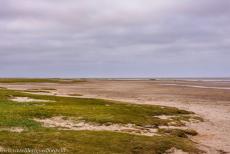
The Wadden Sea extends through three countries, from Den Helder in the Netherlands, past the great river estuaries in northwest Germany to the city of Esbjerg in Denmark. The Wadden Sea is the largest intertidal zone in the world and also the largest continuous national park in Europe. The Waden Sea provides a special and extreme environment for animals and salt tolerant plants and is an important breeding area for birds, such as the Eurasian spoonbill and Kentish plover.
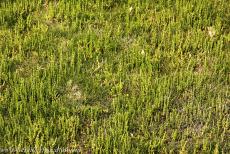
Wadden Sea: Salicornia, known as samphire greens or marsh samphire. The salt marshes of the Wadden Sea are covered with salt tolerant plants, samphire is a pioneer saltmarsh plant, it can survive on soils with high salt concentrations. The Wadden Sea National Park Vadehavet is the largest national park of Denmark. It is visited twice a year by 12 million migratory birds and has the largest population of harbour seals in Denmark.
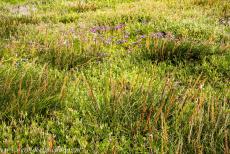
In the foreground of the photo saltmarsh arrowgrass, Triglochin maritima. The Wadden Sea is the largest unbroken system of intertidal sands and mud flats in the world. The massive stretch of salt marshes of the Wadden Sea are covered with salt tolerant plants. Nowadays, the Wadden Sea is threatened by human activities such as gas drilling. Due to human activities, bird species are threatened to disappear from the Wadden Sea. Some birds at risk are the Arctic tern, dunlin, eider, common snipe, avocet, oystercatcher and ruff.
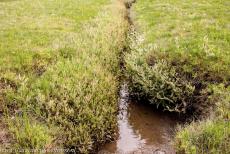
One of the salt tolerant plants of the Wadden Sea is the sea purslane, the Atriplex portulacoides. When the tidal waters retreat, the exposed seabed of the Wadden Sea comes to life and teems with small creatures, such as starfish and mussels. The sands and the dunes of the Wadden Sea are resting places for colonies of seals. A mud flat walking tour is an adventurous way to explore the nature reserve and a unique way to experience the Wadden Sea. The Wadden Sea is one of the most treacherous seas in Europe, so only take a mud walking tour with a licensed guide.
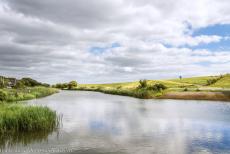
The Wadden Sea, Denmark: The Sneum Å River flows into the Wadden Sea through the Sneum Lock, a sluice gate. The sluice gate is situcated close to the Sneum Dike Lake, the Sneum Digesø. The lake lies just inside the sea dyke. Since 1991, it has been created through digging the clayey soil to reinforce the dykes along the Wadden Sea. The Sneum Digesø is among the best places for birdwatching in Denmark, 264 bird species have been spotted at the same time.
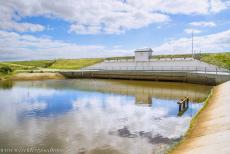
The Wadden Sea in Denmark: The Sneum Lock at the mouth of the Sneum Å River. Most of the rivers which flow into the Wadden Sea are regulated by dykes and sluices. The Sneum Lock is situated about 14 km southeast of Esbjerg. The Dutch part and the German part of the Wadden Sea were declared a UNESCO World Heritage in 2009, the Nationalpark Vadehavet, the Danish part of the Wadden Sea, was added in 2014.
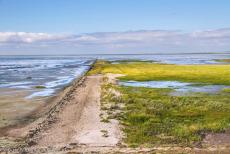
Danish Wadden Sea: A 9 km long concrete causeway leads over the salt marshes of the Wadden Sea to Rømø, the southernmost Wadden Sea Island of Denmark. Nationalpark Vadehavet covers the Danish part of the Wadden Sea from the German border to the Ho Bugt near Esbjerg, it also includes the islands Rømø, Mandø, Fanø and Langli, the Skallingen Peninsula, the Varde Å River Valley and many marshlands, such as the marshlands around Tønder and Ribe.
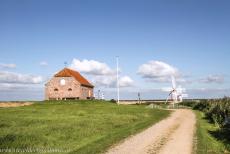
Wadden Sea in Denmark: The Ballum Enge watering mills and mill house near Bredebro. In the period 1842 -1965, the mills in the Ballum Enge were used to provide fresh water for livestock. The mills are surrounded by the Balummarsken, the salt marshes of Ballum. The Ballum Enge is located just behind the dykes of the Wadden Sea between the towns of Tønder and Ribe. Ribe is the oldest town in Denmark.
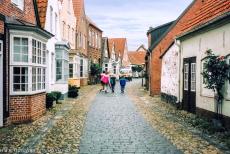
The historic centre of the Danish town of Tønder is dominated by 17th and 18th century houses. Tønder is the oldest market town in Denmark, located near the Wadden Sea. Tønder was once a Hanseatic City, the port of Tønder lost direct access to the Wadden Sea due to land reclamation. The Sort Sol, the Black Sun, is a special nature phenomenon in the marshlands near Tønder and Ribe, the oldest town of Denmark.
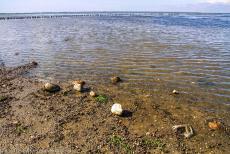
The Wadden Sea is also an important breeding area and tanking station for migrating birds. The sea is a rich feeding ground for bird species, the mud and sand flats are exposed at low tide, it gives birds an easy access to snails, worms, mussels, crabs and shrimps. About 2300 species of flora and fauna can be found in the salt marshes of the Wadden Sea. Animals such as seals live in the Wadden Sea and give birth to their pups on the sandflats.
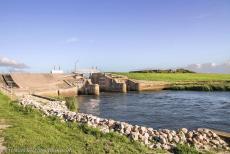
Wadden Sea: The Højer Lock is situated west of Tønder, it was built in the Højer-Siltoft Dyke in 1861. The Sort Sol (Black Sun) is a nature phenomenon in the marshlands near Tønder and Ribe. In spring and autumn, Hundreds of thousands of starlings gather in enormous flocks and form huge formations in the sky, the starlings seem to obscure the sun, thats why it's called the Black Sun. The Sort Sol takes place during the sunset, just before the birds decide to find a location to roost for the night.
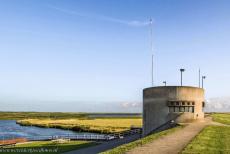
The Danish part of the Wadden Sea: The Højer Vidå Lock was built in 1980 near the Højer Lock. The Vidåen River runs through the Advanced Dyke at the Højer Vidå Lock, the dyke is also called the German-Danish Dike. The dyke stretches across the border between Denmark and Germany and is 12 km long. The sea dyke was built in 1980 to protect Tønder and the Tønder marshlands against flooding.
